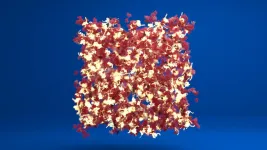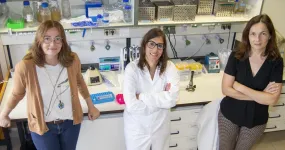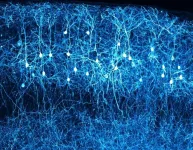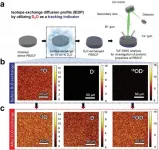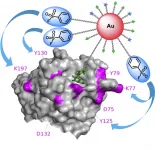Digital pens provide new insight into cognitive testing results
Use of a digital pen during cognitive assessments allows researchers to identify patterns of test performance that correlate with different measures of cognitive and physical function
2021-07-06
(Press-News.org) (Boston)--During neuropsychological assessments, participants complete tasks designed to study memory and thinking. Based on their performance, the participants receive a score that researchers use to evaluate how well specific domains of their cognition are functioning.
Consider, though, two participants who achieve the same score on one of these paper-and-pencil neuropsychological tests. One took 60 seconds to complete the task and was writing the entire time; the other spent three minutes, and alternated between writing answers and staring off into space. If researchers analyzed only the overall score of these two participants, would they be missing something important?
"By looking only at the outcome, meaning what score someone gets, we lose a lot of important information about how the person performed the task that may help us to better understand the underlying problem," explains lead author Stacy Andersen, PhD, assistant professor of medicine at Boston University School of Medicine (BUSM).
Researchers with the Long Life Family Study (LLFS) used digital pens and digital voice recorders to capture differences in study participants' performance while completing a cognitive test and found that differences in 'thinking' versus 'writing' time on a symbol coding test might act as clinically relevant, early biomarkers for cognitive/motor decline.
Participants in the LLFS were chosen for having multiple siblings living to very old ages. Longevity has long been associated with an increased health span and thus these families are studied to better understand contributors to healthy aging. The participants were assessed on a number of physical and cognitive measures, including a symbol coding test called the Digit Symbol Substitution Test.
This timed test requires participants to fill in numbered boxes with corresponding symbols from a given key and assesses both cognitive (attention and processing speed) and non-cognitive factors (motor speed and visual scanning). To allow researchers to collect data about how a participant went about completing the task, the participants used a digital pen while completing the test. On the tip of this pen was a small camera that tracked what and when a participant wrote. The LLFS researchers divided the output from this digital pen into 'writing time' (the time the participant spent writing) and 'thinking time' (the time not spent writing) and looked at how these changed over the course of the 90-second test.
The researchers then identified groups of participants that had similar patterns of writing time and thinking time across the course of the test. They found that although most participants had consistent writing and thinking times, there were groups of participants who got faster or slowed down. "This method of clustering allowed us to look at other similarities among the participants in each group in terms of their health and function that may be related to differences in writing and thinking time patterns," said coauthor and lead biostatistician Benjamin Sweigart, a biostatistics doctoral student at Boston University School of Public Health. The researchers found that those who got slower in writing the symbols during the test had poorer physical function on tests of grip strength and walking speed. In contrast, those who changed speed in thinking time had poorer scores on memory and executive function tests suggesting that writing time and thinking time capture different contributors to overall performance on the test.
According to the researchers, these findings show the importance of capturing additional facets of test performance beyond test scores. "Identifying whether poor test performance is related to impaired cognitive function as opposed to impaired motor function is important for choosing the correct treatment for an individual patient" adds Andersen. "The incorporation of digital technologies amplifies our ability to detect subtle differences in test behavior and functional abilities, even on brief tests of cognitive function. Moreover, these metrics have the potential to be very early markers of dysfunction."
INFORMATION:
These findings appear online in the Journal of Alzheimer's Disease.
Other co-authors included Nancy Glynn of the University of Pittsburgh's Department of Epidemiology; Mary Wojczynski of Washington University School of Medicine's Department for Genetics; Bharat Thyagarajan of University of Minnesota School of Medicine's Department of Laboratory Medicine and Pathology; Jonas Mengel-From of the University of Southern Denmark's Institute of Public Health, Epidemiology, Biostatistics and Biodemography Unit; Stephen Thielke of Puget Sound VA Medical Center's Geriatric Research, Education, and Clinical Center; Thomas Perls of BUSM's Geriatrics Section; David Libon of Rowan University's School of Osteopathic Medicine at the New Jersey Institute for Successful Aging; Rhoda Au of BUSM's Department of Anatomy and Neurobiology and Neurology; Stephanie Cosentino of the Cognitive Neuroscience Division of the Department of Neurology at the Taub Institute for Research on Alzheimer's Disease and the Aging Brain and Paola Sebastiani of Tufts Medical Center's Institute for Clinical Research and Health Policy Studies.
Funding for this study was provided by the National Institute on Aging (K01AG057798 to S.L.A., U01AG023749 to S.C., U01AG023755 to T.T.P., U01AG023712, U01AG023744, U01AG023746, U19AG063893); the National Institute of General Medical Sciences Interdisciplinary Training Grant for Biostatisticians Uncorrected Author Proof S.L. Andersen et al. / Digital Patterns of Processing Speed 15 (T32 GM74905) to B.S.; the Boston University School of Medicine Department of Medicine Career Investment Award to S.L.A.; and the Marty and Paulette Samowitz Foundation to T.T.P. Additionally, the Claude D. Pepper Older Americans Indepen dence Center, Research Registry and Developmental Pilot Grant (NIH P30 AG024827), and the Intramural Research Program, National Institute on Aging supported N.W.G. to develop the Pittsburgh Fatigability Scale.
Note to Editors
Stacy L. Andersen
* Consulting Fees:
I have received $10,000 over the past two years for research consulting for Washington University which is unrelated to the project in this manuscript.
Rhoda Au
* Consulting Fees:
Signant Health, Scientific Advisory Board - 1-2 x per year Biogen, Scientific Advisor, Diversity Advisory Board - sporadically
Grants
* Agency:
Evidation Health
Dates:
3-1-18 to 3-1-21
Stephanie Cosentino
* Consulting Fees:
I receive consulting fees from Sage and the Association for FTD
Nancy W. Glynn
* Nothing to Disclose
David J. Libon
* Patents/Royalties
Dr. Libon receives royalties from Oxford University Press
ELSE PRESS RELEASES FROM THIS DATE:
2021-07-06
BOSTON -- As we age, our brains typically undergo a slow process of atrophy, causing less robust communication between various brain regions, which leads to declining memory and other cognitive functions. But a rare group of older individuals called "superagers" have been shown to learn and recall novel information as well as a 25-year-old. Investigators from Massachusetts General Hospital (MGH) have now identified the brain activity that underlies superagers' superior memory. "This is the first time we have images of the function of superagers' brains as they actively learn and remember new information," says Alexandra Touroutoglou, PhD, director of Imaging ...
2021-07-06
Scientists at the University of Leeds have developed an approach that could help in the design of a new generation of synthetic biomaterials made from proteins.
The biomaterials could eventually have applications in joint repair or wound healing as well as other fields of healthcare and food production.
But one of the fundamental challenges is to control and fine tune the way protein building blocks assemble into complex protein networks that form the basis of biomaterials.
Scientists at Leeds are investigating how changes to the structure and mechanics of individual protein building blocks - changes at the nanoscale - can alter the structure and mechanics of the biomaterial ...
2021-07-06
Two model studies document the probability of climate tipping in Earth subsystems. The findings support the urgency of restricting CO2 emissions as abrupt climate changes might be less predictable and more widespread in the climate system than anticipated. The work is part of the European TiPES project, coordinated by the University of Copenhagen, Denmark but was conducted by Professor Michael Ghil, Ecole Normale Supérieure, Paris, France and coauthours from The Royal Meteorological Institute of Belgium and Parthenope University of Naples, Italy.
Tipping could be imminent
It is often assumed climate change will proceed gradually as we increase the amounts of CO2 in ...
2021-07-06
Streptococcus pneumoniae is a major human pathogen and a leading cause of several infectious diseases including pneumonia, the third-leading cause of death in Portugal. In Europe, S. pneumoniae is the most common cause of community-acquired bacterial pneumonia in adults. Still, very little is known about its colonization within this age group. A team of researchers from ITQB NOVA has now taken a crucial step to clarify the dynamics of carriage of this bacterium in adults.
This bacterium, also known as pneumococcus, can asymptomatically colonize the human upper respiratory tract. Colonization not only precedes diseases but is also essential for transmission. Even ...
2021-07-06
In 2011, scientists confirmed a suspicion: There was a split in the local cosmos. Samples of the solar wind brought back to Earth by the Genesis mission definitively determined oxygen isotopes in the sun differ from those found on Earth, the moon and the other planets and satellites in the solar system.
Early in the solar system's history, material that would later coalesce into planets had been hit with a hefty dose of ultraviolet light, which can explain this difference. Where did it come from? Two theories emerged: Either the ultraviolet light came from our then-young sun, or it came from a large nearby star in the sun's stellar nursery.
Now, researchers from the lab of Ryan Ogliore, assistant professor of physics in Arts ...
2021-07-06
The neocortex is a layered structure of the brain in which neurons are arranged parallel to each other. This organization is critical for healthy brain function. A team of researchers from Charité - Universitätsmedizin Berlin have uncovered two key processes that direct this organization. Reporting in Science Advances*, the researchers identify one crucial factor which ensures the timely movement of neurons into their destined layer and, subsequently, their final parallel orientation within this space.
The neocortex is the outer region of the brain. It is responsible for cognitive functions such as language, decision-making, and ...
2021-07-06
A research team, led by Professor Guntae Kim in the School of Energy and Chemical Engineering at UNIST has introduced an innovative way to quantify proton kinetic properties of triple (H+/O2?/e?) conducting oxides (TCOs) being a significant indicator for characterizing the electrochemical behavior of proton and the mechanism of electrode reactions.
Layered perovskites have recently received much attention as they have been regarded as promising cathode materials for protonic ceramic fuel cells (PCFCs) that use proton conducting oxide (PCO) as an electrolyte. Therefore, quantitative characterization of the proton kinetics in TCO can be an important indicator providing a scientific ...
2021-07-06
Psychologists from UNSW Sydney have developed a new face identification ability test that will help find facial recognition experts for a variety of police and government agencies, including contract tracing.
The Glasgow Face Matching Test 2 [GFMT2] targets high-performing facial recognition individuals known as super-recognisers, who have an extraordinary ability to memorise and recall faces.
The type of professional roles that involve face identification and that could benefit from the test include visa processors, passport issuers, border control officers, ...
2021-07-06
Cells play a precise game of telephone, sending messages to each other that trigger actions further on. With clear signaling, the cells achieve their goals. In disease, however, the signals break up and result in confused messaging and unintended consequences. To help parse out these signals and how they function in health -- and go awry in disease -- scientists tag proteins with labels they can follow as the proteins interact with the molecular world around them.
The challenge is figuring out which proteins to label in the first place. Now, a team led by researchers from Tokyo University of Agriculture and Technology (TUAT) has developed a new approach to identifying and tagging the specific proteins. They published their results on June 1 in Angewandte ...
2021-07-06
AUSTIN, Texas -- A diagnostic tool called the MasSpec Pen has been tested for the first time in pancreatic cancer patients during surgery. The device is shown to accurately identify tissues and surgical margins directly in patients and differentiate healthy and cancerous tissue from banked pancreas samples. At about 15 seconds per analysis, the method is more than 100 times as fast as the current gold standard diagnostic, Frozen Section Analysis. The ability to accurately identify margins between healthy and cancerous tissue in pancreatic cancer surgeries can give patients the greatest chance of survival.
The results, by a team from ...
LAST 30 PRESS RELEASES:
[Press-News.org] Digital pens provide new insight into cognitive testing results
Use of a digital pen during cognitive assessments allows researchers to identify patterns of test performance that correlate with different measures of cognitive and physical function
